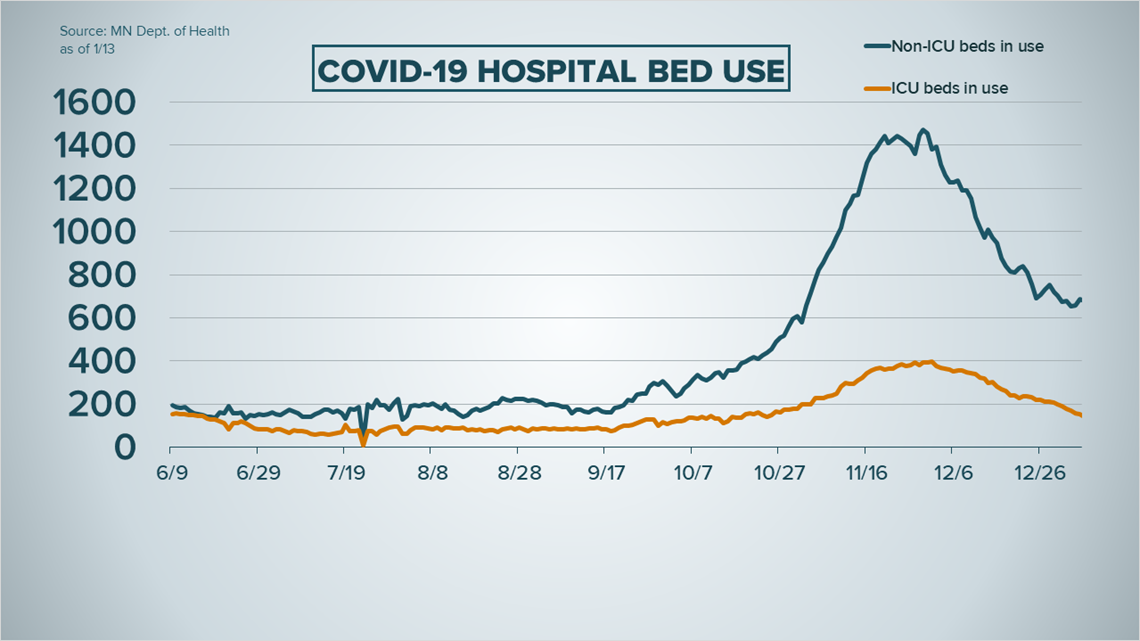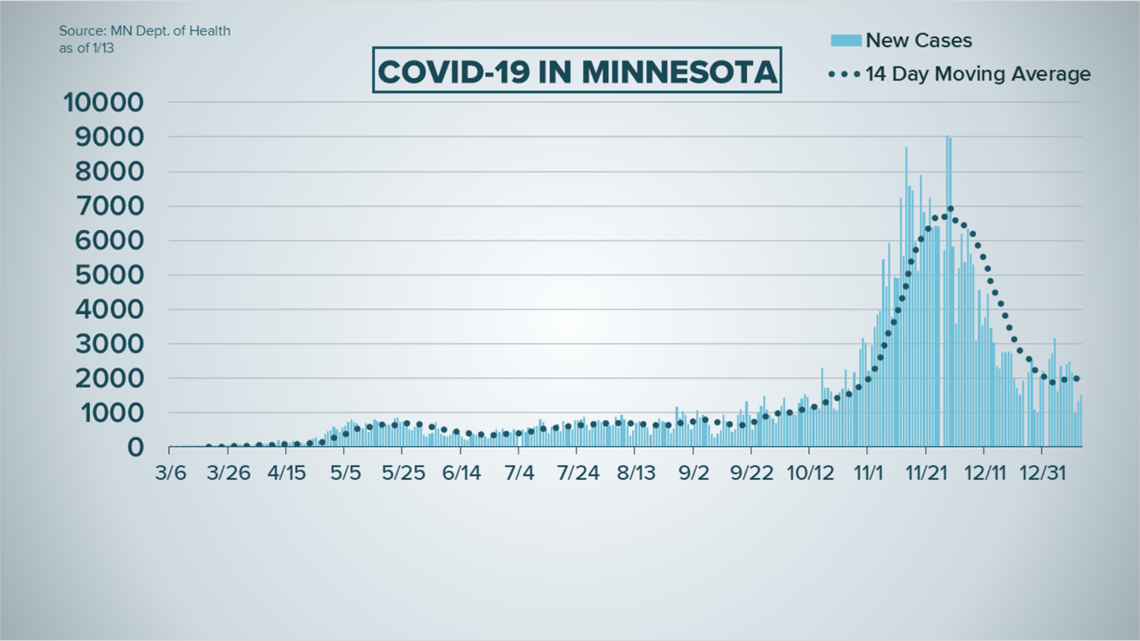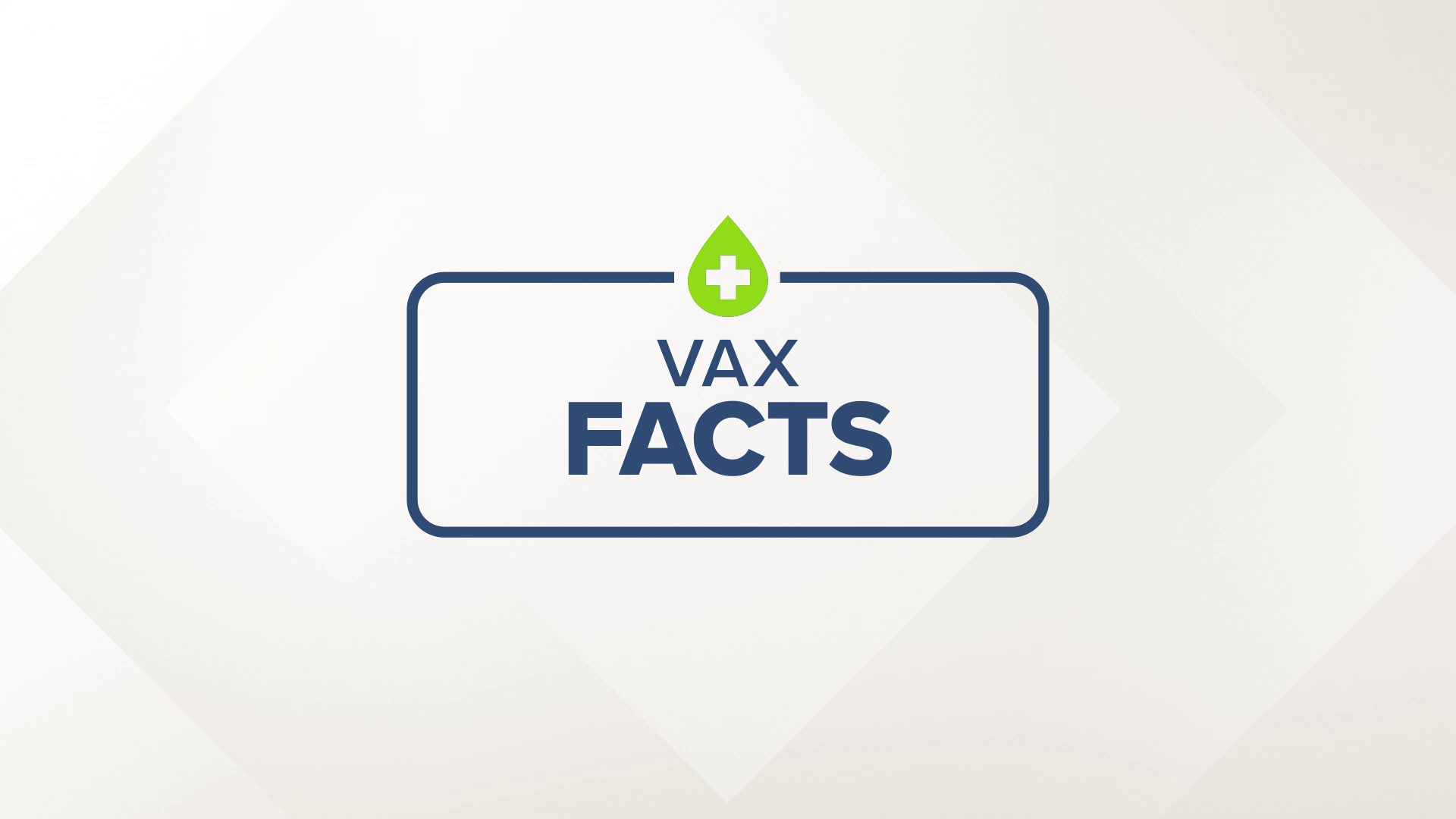ST PAUL, Minn. — Thursday, Jan. 14
- Winter weather closes three community testing sites early: Albert Lea, Morris and Worthington
- MDH says new federal vaccine guidelines "surprised all of us"
- Minnesota providers now allowed flexibility to vaccinate some broader groups if they have available doses
- State health officials unveil new vaccine dashboard
- New COVID variant to be an "important variable" in Minnesota's trends
2 p.m.
The Minnesota Department of Health (MDH) is telling providers that they can broaden some vaccination groups if they have available doses.
Following the changes in federal guidance on vaccine administration, Health Commissioner Jan Malcolm said, MDH informed providers on Thursday that they can begin to provide vaccines to broader categories of people, including those 65 years of age and older.
That announcement is intended to allow providers to use their doses as quickly as possible, Malcolm said.
"We've been hearing feedback from some of our partners, that ... have made good progress in getting through some of the first stages of this vaccine rollout," Malcolm said. She said those providers are asking for flexibility to start vaccinating some of the next group of Minnesotans that will be eligible.
"We are approaching the end of our earliest stages of the vaccine rollout and are pleased with the progress that's been made," Malcolm said.
Malcolm said MDH is beginning to vaccinate in assisted living facilities, after making good progress in skilled nursing facilities and with frontline health care workers.
"We have far more Minnesotans eligible for getting the vaccine than we have doses available from the federal government," Malcolm said. "Now we really need the federal government to step up and supply us with additional doses of vaccine to make that possible."
Malcolm clarified that Minnesota is not moving to the next phase of vaccinations. MDH is just offering flexibility to providers who have made good progress through the priority tiers and want to use the extra doses they have available.
"We want to remove any barriers to their use," she said.
Malcolm promised to have more information about the next priority groups in Minnesota in the coming days.
"We will be communicating much more broadly with Minnesotans about how we will be making more opportunities available," Malcolm added. "And our ability to actually provide vaccine to those expanded population groups ... is going to depend on how quickly the supply of those vaccines can ramp up."
On Thursday's regular media briefing call, Malcolm reported that nearly 1,600 new COVID-19 cases were reported on Thursday, slightly over Wednesday's total, on a much higher testing volume than Wednesday.
Hospital bed use in Minnesota went down by 20 beds in total, Malcolm said.
The seven-day rolling average of Minnesotans admitted to the hospital with COVID-19 has been stable and declining.
Due to winter weather, an MDH spokesperson said some COVID-19 community testing sites are closing early Thursday. Albert Lea is closing at 3:30 p.m., Morris closing at 2:30, Worthington closing at 3:30.
Dr. Ruth Lynfield, the state epidemiologist, provided an update on multisystem inflammatory syndrome in children (MIS-C). She said Minnesota has seen 56 confirmed cases of MIS-C, and no deaths. The average age is 7 and a half years old, but the range is wide. Seventy percent are male, and MDH continues to see a racial disparity. Sixty percent are Black or Hispanic children.
"We are seeing more MIS-C cases now than last fall, however I want to reminder you that it is still extremely rare.
The 56 cases come out of more than 70,000 COVID-19 cases among children in Minnesota - that's less than one-tenth of 1%, Lynfield said.
The similar syndrome in adults, MIS-A, appears to be related to COVID-19, occurring in adults older than 21. It is thought to be even more rare than MISC, Lynfield said. She said MDH has heard of five cases in Minnesota.
Regarding the new COVID-19 variant that originated in the UK and was recently identified in Minnesota, Malcolm said the virus strain is an "important variable."
She said while recent trends in Minnesota have stabilized, the new variant could have an impact on case growth moving forward.
"We don't have any specific projections that we've done about what this might do to case growth, but it's certainly one among many variables," she said.
Malcolm encouraged Minnesotans to continue to pay close attention to social distancing, masking, staying home when sick and other public health guidance.
"There is no new strategy above and beyond the strategies that we have been employing and that we know are effective," she said.
11 a.m.
The number of new COVID-19 cases in Minnesota remains steady, according to data released Thursday by state health officials, but the virus claimed an additional 43 lives in the last day.
Minnesota Department of Health (MDH) statistics say reports from around the state show 1,598 more people have tested positive for coronavirus, based on results from 36,678 tests (32,982 PCR, 3,696 antigen) processed in private and state labs. Testing volume was up from numbers reported in recent days.
Health officials consider a positive PCR test a confirmed COVID case, while a positive antigen test is considered a probable case.
The new cases reported Thursday bring Minnesota's total to 441,935, of which 17,351 are attributed to antigen tests.
MDH says 43 more people have died from COVID-19, bringing fatalities since the arrival of the pandemic to 5,817. Of those deaths 3,716, or 64% are tied to long-term care or assisted living settings.


The department's new vaccine dashboard says 153,332 Minnesotans have received at least one vaccine dose, while 15,082 have completed the two-dose series. Those people are mostly front line health care workers, first responders and those from vulnerable populations.
Minnesota health care providers have received 400,450 doses of vaccine from suppliers as of Wednesday, and the CDC has shipped an additional 104,900 doses as part of a long-term care vaccination program. MDH says of the doses the state has received, 33.5% have been administered.
As of Wednesday 645 hospital beds across the state are being used to treat COVID-19 patients, with 131 of those beds being in the ICU. Bed availability is lowest in southeastern Minnesota and the Twin Cities metro. Twin Cities hospitals report just 3% of non-ICU beds are currently open (111) while 7.1% of beds in their ICUs are available (49).
Total hospitalizations since the onset of the virus now stand at 23,113, with 4,836 of those patients requiring care in the ICU.
MDH reports that 420,919 people who at one time tested positive for coronavirus have recovered to the point they no longer need to be isolated.


Young adults between the ages of 20 to 24 make up the largest group of the state's COVID cases with 44,632 and three deaths, followed by their 25 to 29-year-old counterparts with 39,844 cases and six deaths. People between 85 and 89 account for the largest grouping of deaths with 1,099 deaths in 5,819 confirmed cases.
Hennepin County continues to report the most COVID activity with 91,859 cases and 1,461 deaths, followed by Ramsey County with 39,405 cases and 729 deaths, Dakota County with 32,551 cases and 324 deaths, and Anoka County with 30,638 cases and 354 fatalities.
Cook County in northeastern Minnesota has the least COVID activity with 113 cases and zero deaths.
Wednesday, Jan. 13
11 a.m.
COVID-19 has claimed the lives of 50 more Minnesotans, according to data released Wednesday by state health officials.
The Minnesota Department of Health (MDH) now says 5,774 people have died from coronavirus since the pandemic arrived in the state. Of those deaths 3,693, or 64% of them, are linked to assisted living or long-term care settings.
The 50 deaths are the most reported in a single day since Jan. 6, when MDH recorded 67.
MDH says 1,504 new cases were recorded in the past day, based on results from 23,956 tests (18,694 PCR, 5,262 antigen) processed in private and state labs. Health officials consider a positive PCR test a confirmed COVID case, while a positive antigen test is considered a probable case.
Those new cases bring the state total to 440,354, of which 17,125 are a result of antigen tests.


The state's new vaccine dashboard says 146,901 Minnesotans have received at least one dose of COVID-19 vaccine, while 7,928 have completed the two-dose series. Minnesota health care providers have received 383,625 doses of vaccine, while the CDC has shipped 103,700 to Minnesota as part of the federal long-term vaccination program. At this point 32% of all doses received have been administered.
Hospitalizations continue to drop statewide, with 665 beds currently being used to treat COVID patients. Of those patients, 129 are being treated in ICU. Hospital bed availability in the Twin Cities took a slight drop in the past day, with just 137 non-ICU beds open (3.7%) and only 45 ICU beds open (6.5%).
In total, 23,018 people have been hospitalized with coronavirus since the start of the pandemic, with 4,822 of those patients requiring ICU care.


Young adults account for the largest groupings of COVID cases in Minnesota, with those 20 to 24-years old making up 44,479 cases and three deaths, followed by people 25 to 29 with 39,701 cases and six deaths.
The age group linked to the most deaths from the virus is 85 to 89-year-olds, with 1,088 fatalities in just 5,798 diagnosed cases.
Hennepin County has recorded the most COVID activity in the state with 91,596 cases and 1,449 deaths, followed by Ramsey County with 39,305 cases and 726 deaths, Dakota County with 32,427 cases and 317 deaths, and Anoka County with 30,560 cases and 355 fatalities.
Cook County in northeastern Minnesota has the least recorded COVID activity with 112 cases and zero deaths.
KARE 11’s coverage of the coronavirus is rooted in Facts, not Fear. Visit kare11.com/coronavirus for comprehensive coverage. Have a question? Text it to us at 763-797-7215. And get the latest coronavirus updates sent right to your inbox every morning. Subscribe to the KARE 11 Sunrise newsletter here. Help local families in need: www.kare11.com/give11.
The state of Minnesota has set up a data portal online at mn.gov/covid19.

